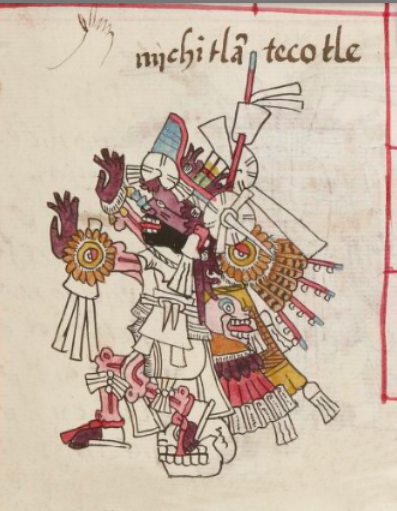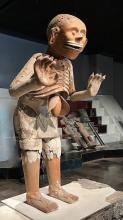Mictlantecuhtli (TR15r)
This iconographic example shows an anthropomorphic representation of the divine force of death, the lord (tecuhtli) of the place of the dead (mictlan). This figure is shown in profile view, facing the viewer's left. It is laden with symbolism, drawn and painted with many colors, and decorated with feathers, paper, shells, and more. But, at his feet, is a white skull, which points to death. Much of its body is also skeletal, with the arms and legs consisting of bone. Many part of his regalia are white, a color associated with mortuary practices and death. The starry eyes (with the red eyelids) have that association, too. Mummy bundles were sometimes decorated with paper ornaments as are found on this figure. On his head is a turquoise-blue diadem with red trim. The diadem speaks to his title as lord (tecuhtli). The way the figure's legs are bent is suggestive of movement, perhaps dancing.
Stephanie Wood
The mismanagement of the gloss suggests that the writer was not a native speaker, but the painter surely was. Mictlantecuhtli ruled the underworld and was the divine force associated with death. Eloise Quiñones Keber notes that his female consort was Mictecacihuatl. She adds: "Mictlan, which was believed to be located in the north" is described in the Florentine Codex "as a dark, cold, dismal place that was the final destination of those who died an ordinary death." [For more on this figure, see her study, Codex Telleriano-Remensis, 1995, 176.]
Stephanie Wood
michitlā tecotle
Mictlantecuhtli
Stephanie Wood
ca. 1550–1563
Jeff Haskett-Wood
la muerte, deidades, inframundo, underworld, divinidades, fuerzas divinas, feathers, plumas, shells, stars, estrellas, eyes, ojos, bones, huesos, hueso
Mictlantecuhtli. Museo del Templo Mayor. According to the Museo, this ceramic sculpture is "a half-gaunt being in a position of attack, with claws and curly hair, probably placed using the holes he has in his head. The liver hangs under his thorax, because according to Aztec beliefs, this internal organ was closely related with Mictlan or the Underworld.... we know that the Aztecs used to offer blood to" him. Photograph by Stephanie Wood, 15 February 2023.
mictlan, place of the dead, https://nahuatl.wired-humanities.org/content/mictlan
tecuht(li), lord, https://nahuatl.wired-humanities.org/content/tecuhtli
El Señor del Inframundo
Stephanie Wood
Telleriano-Remensis Codex, folio 15 recto, MS Mexicain 385, Gallica digital collection, https://gallica.bnf.fr/ark:/12148/btv1b8458267s/f55.item.zoom
The non-commercial reuse of images from the Bibliothèque nationale de France is free as long as the user is in compliance with the legislation in force and provides the citation: “Source gallica.bnf.fr / Bibliothèque nationale de France” or “Source gallica.bnf.fr / BnF.”




